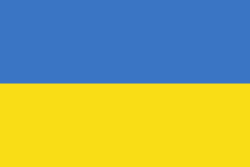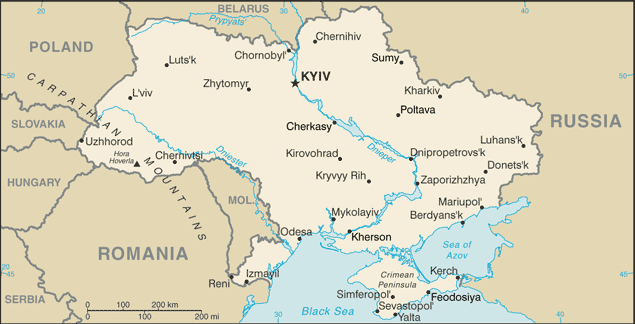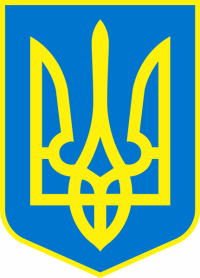Ukraine
Related Categories:
 Flag of Ukraine
Flag of UkraineTwo equal horizontal bands of azure (top) and golden yellow represent grain fields under a blue sky. |

 Ukraine Coat of Arms
Ukraine Coat of Arms |
The colors of the flag symbolized the Kyivan State even before the Rus was baptized. During the times of the Tartar yoke of Baty-khan, this symbolism disappeared to be revived later on in the church ritual decorations and blazonry of Ukrainian towns.
www.mfa.gov.ua/
The Flag, Legislation, Previous Provisional Legislation, Flag with Arms.
www.fotw.us/flags/ua.html
From at least the ninth century, the territory of present-day Ukraine was a centre of medieval East Slavic civilization forming the state of Kievan Rus, and for the following several centuries the territory was divided between a number of regional powers.
en.wikipedia.org/
The population of Ukraine is about 46.9 million. Ethnic Ukrainians make up about 73% of the total; ethnic Russians number about 22%, ethnic Belarusians number about 5%. The industrial regions in the east and southeast are the most heavily populated, and the population is about 67% urban. Ukrainian and Russian are the principal languages. Although Russian is very widely spoken, in the 1989 census (the latest official figures) 88% of the population identified Ukrainian as their native language. There are also small Tatar and Hellenic minorities centered mainly in Crimea. The dominant religions are the Ukrainian Orthodox Church and the Ukrainian Greek Catholic Church (which practices Orthodox rites but recognizes the Roman Catholic Pope as head of the Church). The Ukrainian Orthodox Church is divided between a Moscow Patriarchate and a separate Kyiv Patriarchate, which was established after Ukrainian independence and which declared independence from Moscow. In addition to these, there are also the Ukrainian Autocephalous Orthodox Church and representatives of the Russian Orthodox Church Abroad.
The birth rate in Ukraine is declining. About 70% of adult Ukrainians have a secondary or higher education. Ukraine has about 150 colleges and universities, of which the most important are in Kyiv, Lviv, and Kharkiv. There are about 70,000 scholars in 80 research institutes.
www.state.gov/r/
Introduction
About
Contact
Symbols in The News
Interpret this Symbol
AAC
African
AI
Alchemy
Alphabets
Ancient
Animal Symbolism
Architecture
Art
Articles
Astrology
Baha'i
Blissymbolics
Blueprint Symbols
Buddhist
Celtic Symbols
Cemetery
Chinese Symbols
Christian
Circle
City
Codes
Color
Conlangs
Crop Circles
Danger
Da Vinci Code
Designing Logos
Dictionaries
Dreams
Education
Egyptian Symbols
Electrical
Emoticons
Find Images
Fonts
Food
Fraternity
Hamsa
Healing
Heraldry
Hermetic
Highway Signs
Hindu
History
Hobo
Holiday
Icons
iConji
Islamic
Jain Symbols
Japanese, Kanji
Jewish
Justice
Law
Literary Symbolism
Mandalas
Map
Masonic
Math, Number
Meaning of Names
Medical
Middle East
Military
Miscellaneous
Money
Music
Mythology
Native American
Playing Cards
Power
Psychology
QiQiiKhu
Reiki
Religious
Runes, Norse
Sacred Geometry
Scientific
Science Fiction
Sorority
Sports
Symbols in the News
Tattoos
ThirteenSymbols
Tree of Life
Ursprache
Videos
Visual Languages
Weather
Web Codes
Wicca
Words
Writing Systems
Braille
Coinherence
Coptic
Cuneiform
Easter Island
Etruscan
Happy Human
Hebrew
Kokopelli
Linear B
Lotus
Love Symbols
Mandorla
Moon Alphabet
Nine Pointed Star
Om
Oz
Phonetic
Scarab Beetle
Silent
Theosophy
Unifon
About
Contact
Symbols in The News
Interpret this Symbol
AAC
African
AI
Alchemy
Alphabets
Ancient
Animal Symbolism
Architecture
Art
Articles
Astrology
Baha'i
Blissymbolics
Blueprint Symbols
Buddhist
Celtic Symbols
Cemetery
Chinese Symbols
Christian
Circle
City
Codes
Color
Conlangs
Crop Circles
Danger
Da Vinci Code
Designing Logos
Dictionaries
Dreams
Education
Egyptian Symbols
Electrical
Emoticons
Find Images
Fonts
Food
Fraternity
Hamsa
Healing
Heraldry
Hermetic
Highway Signs
Hindu
History
Hobo
Holiday
Icons
iConji
Islamic
Jain Symbols
Japanese, Kanji
Jewish
Justice
Law
Literary Symbolism
Mandalas
Map
Masonic
Math, Number
Meaning of Names
Medical
Middle East
Military
Miscellaneous
Money
Music
Mythology
Native American
Playing Cards
Power
Psychology
QiQiiKhu
Reiki
Religious
Runes, Norse
Sacred Geometry
Scientific
Science Fiction
Sorority
Sports
Symbols in the News
Tattoos
ThirteenSymbols
Tree of Life
Ursprache
Videos
Visual Languages
Weather
Web Codes
Wicca
Words
Writing Systems
Braille
Coinherence
Coptic
Cuneiform
Easter Island
Etruscan
Happy Human
Hebrew
Kokopelli
Linear B
Lotus
Love Symbols
Mandorla
Moon Alphabet
Nine Pointed Star
Om
Oz
Phonetic
Scarab Beetle
Silent
Theosophy
Unifon
